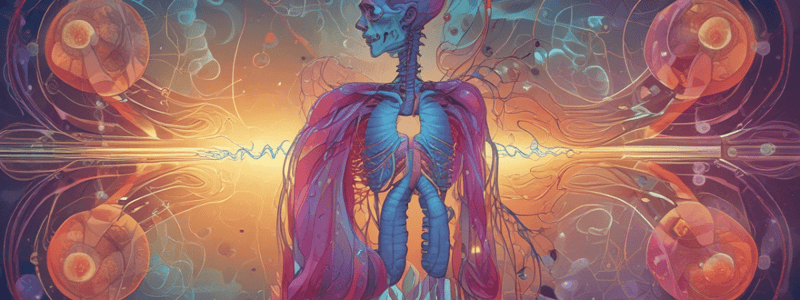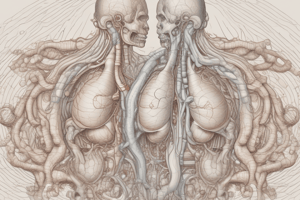Podcast
Questions and Answers
What is the maximum number of oxygen molecules that can bind to each haemoglobin molecule?
What is the maximum number of oxygen molecules that can bind to each haemoglobin molecule?
- 4 (correct)
- 2
- 8
- 6
What is the oxygen capacity of normal blood?
What is the oxygen capacity of normal blood?
- 200 ml.l-1 (correct)
- 300 ml.l-1
- 250 ml.l-1
- 150 ml.l-1
What is the oxygen content of pulmonary venous blood?
What is the oxygen content of pulmonary venous blood?
- 150 ml.l-1
- 250 ml.l-1
- 180 ml.l-1
- 200 ml.l-1 (correct)
What is the saturation level of mixed venous blood?
What is the saturation level of mixed venous blood?
What is the concentration of haemoglobin in normal blood?
What is the concentration of haemoglobin in normal blood?
What happens to the 3D structure of haemoglobin when it binds to oxygen?
What happens to the 3D structure of haemoglobin when it binds to oxygen?
What is the direction of O2 diffusion across the alveolar-capillary membrane?
What is the direction of O2 diffusion across the alveolar-capillary membrane?
At rest, when does the pulmonary capillary PO2 equal alveolar PO2?
At rest, when does the pulmonary capillary PO2 equal alveolar PO2?
What is the primary factor that determines gas transfer between different phases?
What is the primary factor that determines gas transfer between different phases?
Why does CO2 diffuse more rapidly than O2 across the alveolar-capillary exchange surface?
Why does CO2 diffuse more rapidly than O2 across the alveolar-capillary exchange surface?
What happens to gas transfer when the alveolar-capillary unit is disrupted by respiratory disease?
What happens to gas transfer when the alveolar-capillary unit is disrupted by respiratory disease?
What is the effect of increased pulmonary blood flow rate on gas transfer during exercise?
What is the effect of increased pulmonary blood flow rate on gas transfer during exercise?
What is the ratio of the solubility coefficient of CO2 to O2 in plasma?
What is the ratio of the solubility coefficient of CO2 to O2 in plasma?
What is the approximate ratio of the diffusion rate of CO2 to O2 across the alveolar-capillary exchange surface?
What is the approximate ratio of the diffusion rate of CO2 to O2 across the alveolar-capillary exchange surface?
What is the result of increasing inspired oxygen from 21% to 24% in patients with severe chronic lung disease?
What is the result of increasing inspired oxygen from 21% to 24% in patients with severe chronic lung disease?
Why is breathing 100% oxygen insufficient to support life at high altitude?
Why is breathing 100% oxygen insufficient to support life at high altitude?
What happens to oxygen content or saturation when PO2 is close to the normal resting arterial PO2 of 13 kPa?
What happens to oxygen content or saturation when PO2 is close to the normal resting arterial PO2 of 13 kPa?
What is the effect of moderate hypoventilation or a small/moderate fall in inspired PO2 on physical or mental performance?
What is the effect of moderate hypoventilation or a small/moderate fall in inspired PO2 on physical or mental performance?
What happens to oxygen content and saturation when PO2 is below about 8 kPa?
What happens to oxygen content and saturation when PO2 is below about 8 kPa?
Why does a small increase in oxygen consumption lead to a large release of O2 from haemoglobin in tissues?
Why does a small increase in oxygen consumption lead to a large release of O2 from haemoglobin in tissues?
Why can high altitude pilots survive breathing oxygen-enriched air?
Why can high altitude pilots survive breathing oxygen-enriched air?
What is the effect of increasing arterial PO2 by using oxygen-enriched air in patients with severe hypoventilation or hypoxic lung disease?
What is the effect of increasing arterial PO2 by using oxygen-enriched air in patients with severe hypoventilation or hypoxic lung disease?
What is the rate of transfer of gas through a sheet of tissue dependent on?
What is the rate of transfer of gas through a sheet of tissue dependent on?
What is the unit of measurement for the pressure gradient driving diffusion across the alveolar-capillary membrane?
What is the unit of measurement for the pressure gradient driving diffusion across the alveolar-capillary membrane?
What is the diffusing capacity of the lungs for oxygen?
What is the diffusing capacity of the lungs for oxygen?
What is the rate of transfer of oxygen dependent on?
What is the rate of transfer of oxygen dependent on?
Why is mean pulmonary capillary PCO2 assumed to be zero in the measurement of carbon monoxide diffusing capacity?
Why is mean pulmonary capillary PCO2 assumed to be zero in the measurement of carbon monoxide diffusing capacity?
What is the calculation for carbon monoxide diffusing capacity?
What is the calculation for carbon monoxide diffusing capacity?
What is the purpose of the tracer gas in the measurement of carbon monoxide diffusing capacity?
What is the purpose of the tracer gas in the measurement of carbon monoxide diffusing capacity?
What is the relationship between the diffusing capacity of the lungs for oxygen and the rate of transfer of oxygen?
What is the relationship between the diffusing capacity of the lungs for oxygen and the rate of transfer of oxygen?
What is the primary factor that determines the PO2 of blood?
What is the primary factor that determines the PO2 of blood?
If the blood in the circulation was instantaneously replaced by plasma, what would happen to the mean tissue capillary PO2?
If the blood in the circulation was instantaneously replaced by plasma, what would happen to the mean tissue capillary PO2?
What is the approximate PO2 of plasma as it equilibrates with alveolar gas at sea level?
What is the approximate PO2 of plasma as it equilibrates with alveolar gas at sea level?
In the absence of haemoglobin, what would happen to the PO2 as plasma flows through the tissue capillaries?
In the absence of haemoglobin, what would happen to the PO2 as plasma flows through the tissue capillaries?
What is the role of haemoglobin in maintaining oxygen delivery to the tissues?
What is the role of haemoglobin in maintaining oxygen delivery to the tissues?
What is the effect of a normal haemoglobin concentration on the PO2 along the tissue capillary?
What is the effect of a normal haemoglobin concentration on the PO2 along the tissue capillary?
What would happen to oxygen delivery to the tissues if the blood in the circulation was instantaneously replaced by plasma?
What would happen to oxygen delivery to the tissues if the blood in the circulation was instantaneously replaced by plasma?
What is the primary mechanism by which oxygen is delivered to the tissue cells?
What is the primary mechanism by which oxygen is delivered to the tissue cells?
Flashcards are hidden until you start studying
Study Notes
Gas Transfer and Diffusion
- Gas transfer between phases is determined by the partial pressure gradient, not the concentration gradient.
- Gas moves down a partial pressure gradient from high to low gas partial pressure (Pgas) until a new dynamic equilibrium is reached.
- In the lungs, O2 diffuses from the alveoli into the pulmonary capillary blood, and CO2 diffuses from the pulmonary capillary blood into the alveoli.
- CO2 diffuses at approximately 85% of the rate of O2, but it is 23 times more soluble in plasma, so it equilibrates rapidly across the alveolar-capillary exchange surface.
Factors Affecting Diffusion
- Fick's law: Rate of transfer of gas through a sheet of tissue is proportional to the area, the partial pressure gradient, and inversely proportional to the thickness.
- Gas diffusion is affected by the partial pressure gradient, area, and thickness of the alveolar-capillary membrane.
- Diffusion limitation can occur if the alveolar-capillary unit is disrupted by respiratory disease, especially if pulmonary blood flow rate increases.
Measurement of Oxygen Diffusing Capacity
- DLO2 is the oxygen uptake from the lungs (VO2) divided by the partial pressure gradient (PAO2 - PCO2).
- Carbon monoxide diffusing capacity, DLCO, is a common clinical investigation that measures CO uptake from the lungs.
- Haemoglobin has approximately 240 times the affinity for CO than it does for O2.
Content, Capacity, and Saturation
- Oxygen capacity of normal blood is 200 ml/L, which is the maximum amount of oxygen that can be combined with haemoglobin.
- Oxygen content of blood is the amount of oxygen actually present in the blood, which is typically 150-200 ml/L.
- Oxygen saturation is the percentage of oxygen binding sites on haemoglobin that are occupied, which is typically 75-100%.
Oxyhaemoglobin Dissociation Curve
- The oxyhaemoglobin dissociation curve shows the relationship between oxygen partial pressure and oxygen saturation.
- At high oxygen partial pressures, the curve is flat, indicating little change in oxygen saturation.
- At low oxygen partial pressures, the curve is steep, indicating large changes in oxygen saturation.
- The curve shifts to the right with increased PCO2, temperature, and other factors, which increases oxygen unloading.
High Altitude and Hypoxia
- At high altitude, breathing 100% oxygen is insufficient to support life due to the low oxygen partial pressure.
- High altitude pilots can survive by using pressurized oxygen masks.
- Raising the inspired oxygen content can improve the wellbeing of patients with severe chronic lung disease.
- Oxygen delivery may be adequate for immediate survival, but the subject is very vulnerable to further hypoxia.
Studying That Suits You
Use AI to generate personalized quizzes and flashcards to suit your learning preferences.




